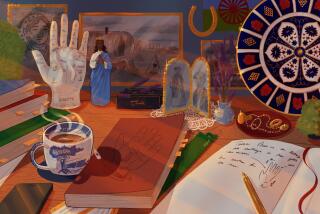Prayer as it links humans to spirit
- Share via
WHEREVER there are humans, “one finds humans at prayer,” Smith College religion scholars Philip and Carol Zaleski write in their new book. Whether people use talismans and enchantments, make sacrificial offerings or de profundis cries of the soul, repeat sacred words in spiritual ecstasies, gather communally or sit in quiet contemplation, they are engaged in an effort to communicate with the divine, the Zaleskis’ definition of prayer.
In “Prayer: A History,” they offer an intriguing look into the practice through ages by all kinds of believers -- Sikhs, Buddhists, Sufis, Christians, Hindus, Muslims, Jews and others. What makes this captivating narrative different from other historical accounts of prayer is its lack of concern with anthropological proof of prayer activities and scientific discussions about why and how people pray. There’s much that science can tell us about prayer and the people who engage in it, but the authors believe that equally valuable lessons can be drawn from participants who have immersed themselves in the vocabulary, grammar and syntax of belief.
Rather than a compendium of traditional categories -- petition, confession, adoration, sacrifice, intercession, etc. -- the book describes the multitude of forms and aims of prayer: a recovering alcoholic reciting the Serenity Prayer, a Catholic nun saying the rosary, a Shaker quaking in divine ecstasy, a yogi meditating, a Huichol Indian chewing a peyote button, a Zen monk in satori, a Lubavitcher dancing with the Torah. Although they acknowledge that there are theological differences that separate such believers, the authors consider the countless ways they are, in fact, similar -- a refreshing perspective in this age of religious conflict.
With a spirit of openness, the Zaleskis delve into magic and mesmerism, and vivid, disparate examples of those who have found refuge in prayer (Robinson Crusoe, Samuel Johnson, Bill W. of Alcoholics Anonymous fame). The book considers devotees to particular forms of prayer -- those who say the Angelus (in which the archangel Gabriel appears to Mary), the Jesus Prayer or repeat the divine name, as well as those who experience raptures, speak in tongues or encounter voodoo possession. In addition to such famous pray-ers as St. Francis, St. Teresa of Avila, India’s Mohandas K. Gandhi and Bengali saint Sri Ramakrishna, Israelite King Solomon, Hasidic movement founder Baal Shem Tov and Christian Science leader Mary Baker Eddy, we meet believers we’ve never heard of, as well as some we know from other realms -- the fine and literary arts, photography and filmmaking -- whose presence here may be surprising, including Jack Kerouac, Wassily Kandinsky, Emily Dickinson and Walt Whitman. In one of the most intriguing sections, the book considers how prayer has influenced the modern arts and how the spiritual hunger of the artist may find its sustenance in the act of creation. After all, as the authors remind us, all art was originally sacred art.
Though the subject matter is weighty, there’s an engaging ease to the Zaleskis’ prose, and humor pops through regularly, as in this assessment of the literary style of the metaphysical healing movements: “The spirit soars upwards on italics and exclamation marks, and barely a noun escapes a pen without being capitalized and raised to a Higher Plane.” How can one not be swayed to investigate contemplative prayer when the authors describe it as one that “wears a thousand carnival masks ... the Mardi Gras of prayer.” Although the book includes many examples of less familiar prayer practices, the focus is on forms of Judeo-Christian prayer. This is not necessarily a detriment, just a fact.
“Prayer,” the Zaleskis tell us, “lies in the ground of our being and connects us to its source, and every creative act bears, manifest or hidden, its imprint.” This thought-provoking and soul-uplifting narrative reveals in concrete and engaging terms the idea of prayer-inspired creation and calls readers, ever so subtly, to investigate the small, still voice within.
Bernadette Murphy, a regular contributor to Book Review, is the author of “Zen and the Art of Knitting.”
*
Prayer
A History
Philip Zaleski and Carol Zaleski
Houghton Mifflin: 416 pp., $29.95
More to Read
Sign up for our Book Club newsletter
Get the latest news, events and more from the Los Angeles Times Book Club, and help us get L.A. reading and talking.
You may occasionally receive promotional content from the Los Angeles Times.










